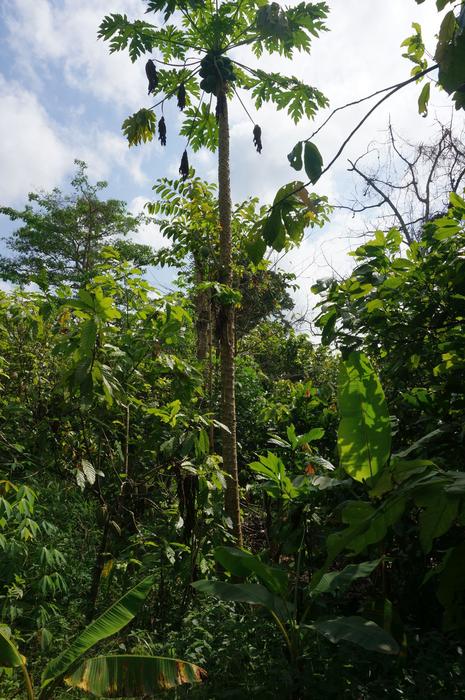The surprising way rising CO2 could supercharge space storms – ScienceDaily

Report on the Evolving Impact of Geomagnetic Storms on Space Infrastructure due to Climate Change
A recent study highlights the significant influence of rising atmospheric carbon dioxide (CO2) concentrations on the interaction between solar events and Earth’s upper atmosphere. This research underscores a critical intersection between climate change and the resilience of global technological infrastructure, directly impacting the achievement of several Sustainable Development Goals (SDGs), notably SDG 9 (Industry, Innovation, and Infrastructure), SDG 11 (Sustainable Cities and Communities), and SDG 13 (Climate Action).
Research Findings on Atmospheric Density Alterations
The study, conducted by the NSF National Center for Atmospheric Research (NSF NCAR) in collaboration with Kyushu University, utilized advanced climate modeling to project the effects of future geomagnetic storms.
Methodology and Simulation
Researchers employed the Community Earth System Model Whole Atmosphere Community Climate Model with thermosphere-ionosphere eXtension (CESM WACCM-X) to analyze the atmospheric response to a geomagnetic superstorm, equivalent to the event of May 2024, under future CO2 emission scenarios for the years 2040, 2061, and 2084. This international partnership exemplifies the collaborative approach advocated by SDG 17 (Partnerships for the Goals).
Key Projections
The simulations revealed a complex shift in atmospheric dynamics:
- Decreased Baseline Density: Increased CO2 levels will lead to a cooling and thinning of the upper atmosphere, reducing its baseline neutral density.
- Lower Absolute Peak Density: During a future geomagnetic storm of the same intensity as one today, the upper atmosphere’s peak density will be 20-50% lower than current levels.
- Greater Relative Density Change: Despite a lower absolute peak, the relative increase in density from the baseline to the storm’s peak will be significantly greater. A storm that currently doubles atmospheric density may nearly triple it in the future.
Implications for Sustainable Development Goals (SDGs)
The findings have profound ramifications for global sustainability efforts, particularly concerning the technological frameworks that support modern society.
SDG 9: Industry, Innovation, and Infrastructure
The global satellite network constitutes a vital component of modern infrastructure, essential for communication, navigation, and data transmission. The study’s findings present new challenges to the resilience of this infrastructure.
- Satellite Operations: The increased variability and relative magnitude of atmospheric drag will impact satellite speed, altitude, and operational longevity, posing a risk to thousands of orbiting assets.
- Infrastructure Design: Future satellites and operational protocols must be designed to withstand these altered atmospheric conditions to ensure the long-term sustainability and reliability of space-based infrastructure.
SDG 11: Sustainable Cities and Communities
The safety and functionality of modern urban centers are increasingly dependent on satellite-based services. Disruptions to GPS, communication networks, and data transmission could compromise urban resilience, affecting everything from emergency response systems to logistical and financial networks.
SDG 13: Climate Action
This research provides compelling evidence of the far-reaching consequences of anthropogenic climate change. It demonstrates that the effects of CO2 emissions are not confined to the lower atmosphere but extend into the near-space environment, fundamentally altering planetary processes. These findings reinforce the urgency of implementing comprehensive climate action to mitigate the cascading impacts on critical global systems.
Conclusion and Future Directives
The study concludes that the relationship between solar activity and Earth’s atmosphere is being fundamentally altered by climate change. This necessitates a new approach to space weather forecasting and satellite engineering. Further research is required to understand the full scope of these changes across different types of geomagnetic events and solar cycles. Integrating climate change projections into space infrastructure planning is critical to safeguarding the technological assets that underpin numerous Sustainable Development Goals.
Sustainable Development Goals (SDGs) Addressed
-
SDG 9: Industry, Innovation and Infrastructure
- The article focuses on the impact of atmospheric changes on “thousands of orbiting satellites.” Satellites are a critical component of modern global infrastructure, essential for navigation, communication, and data transmission. The research addresses the resilience and operational challenges for this technological infrastructure.
-
SDG 13: Climate Action
- The central issue discussed is the effect of “rising concentrations of carbon dioxide in the upper atmosphere.” This directly links the article to climate change, as it explains how greenhouse gas emissions alter atmospheric conditions and exacerbate the effects of natural phenomena like geomagnetic storms.
-
SDG 11: Sustainable Cities and Communities
- While not explicitly mentioned, the reliance of modern society and communities on satellite technology is a key theme. The article notes society’s dependence on “advanced navigation systems, online data transmission, national security applications, and other technologies that rely on satellite operations,” all of which are fundamental to the functioning and resilience of sustainable cities.
-
SDG 17: Partnerships for the Goals
- The research presented is a “collaboration with Japan’s Kyushu University” and the US-based NSF NCAR. This highlights the importance of international scientific partnerships to address complex global challenges like climate change and its impact on technology.
Specific Targets Identified
-
Targets under SDG 9
- Target 9.1: Develop quality, reliable, sustainable and resilient infrastructure. The article directly addresses this by investigating how geomagnetic storms, altered by climate change, pose a threat to the reliability and resilience of satellite infrastructure. The research aims to help the “satellite industry… design satellites for specific atmospheric conditions.”
- Target 9.5: Enhance scientific research, upgrade the technological capabilities of industrial sectors… and encourage innovation. The study itself, published in Geophysical Research Letters and using an “advanced computer model,” is an example of enhancing scientific research to understand and mitigate risks to technological systems.
-
Targets under SDG 13
- Target 13.1: Strengthen resilience and adaptive capacity to climate-related hazards and natural disasters. The article examines how a climate-related hazard (increased CO2) alters the impact of a natural disaster (geomagnetic storms) on critical infrastructure. Understanding these changes is the first step toward strengthening resilience and adapting satellite design and operations.
- Target 13.3: Improve education, awareness-raising and human and institutional capacity on climate change mitigation, adaptation, impact reduction and early warning. The research contributes directly to the body of scientific knowledge, raising awareness about a less-known impact of CO2 emissions on the upper atmosphere and space weather, which is crucial for impact reduction planning.
-
Targets under SDG 11
- Target 11.5: By 2030, significantly reduce… direct economic losses… caused by disasters… with a focus on protecting the poor and people in vulnerable situations. Geomagnetic storms are a form of natural disaster (space weather). By studying their potential to disrupt satellite infrastructure, the research helps in anticipating and potentially mitigating widespread service outages that could cause significant economic losses and affect communities globally.
-
Targets under SDG 17
- Target 17.6: Enhance… international cooperation on and access to science, technology and innovation. The article explicitly mentions that the study was a “collaboration with Japan’s Kyushu University,” demonstrating international cooperation in science and technology to address a shared global challenge.
Indicators for Measuring Progress
-
Indicators for SDG 9 Targets
- For Target 9.1: An implied indicator is the operational longevity and stability of satellites. The article notes that atmospheric drag impacts “how long they remain operational.” Measuring the rate of satellite degradation or failure due to atmospheric drag would be a relevant metric.
- For Target 9.5: A direct indicator is the publication of scientific research and the development of advanced modeling systems. The article mentions its publication in Geophysical Research Letters and the use of the “Community Earth System Model Whole Atmosphere Community Climate Model,” which are tangible outputs of scientific research and innovation.
-
Indicators for SDG 13 Targets
- For Target 13.1: A key indicator mentioned is the change in upper atmosphere density. The study found that future storms will cause the density to be “20-50% less dense at the peak” but that the “relative change in density will be greater.” These measurable atmospheric properties are direct indicators of how climate change is altering a natural hazard.
- For Target 13.3: The number and sophistication of scientific models capable of simulating complex interactions between different atmospheric layers, as described in the article (“simulates the entire atmosphere from Earth’s surface to the upper thermosphere”), can serve as an indicator of institutional capacity and scientific understanding.
-
Indicators for SDG 11 Target
- For Target 11.5: While not directly stated, the article implies the need for an indicator related to the economic and societal impact of space weather. This could be measured by tracking the frequency and duration of satellite service disruptions (e.g., GPS, communication) and their associated economic costs following geomagnetic storms.
-
Indicators for SDG 17 Target
- For Target 17.6: The existence of international co-authorship on scientific publications and joint research projects is a direct indicator. The article’s mention of the collaboration between the US-based NSF NCAR and Japan’s Kyushu University serves as a specific example of this indicator.
Summary Table of SDGs, Targets, and Indicators
| SDGs | Targets | Indicators |
|---|---|---|
| SDG 9: Industry, Innovation and Infrastructure | 9.1: Develop quality, reliable, sustainable and resilient infrastructure. | Operational longevity and stability of satellites under changing atmospheric conditions. |
| SDG 9: Industry, Innovation and Infrastructure | 9.5: Enhance scientific research, upgrade the technological capabilities. | Publication of scientific research and development of advanced computer models (e.g., CESM WACCM-X). |
| SDG 13: Climate Action | 13.1: Strengthen resilience and adaptive capacity to climate-related hazards. | Measurement of upper atmosphere density changes (absolute and relative) during geomagnetic storms due to increased CO2. |
| SDG 13: Climate Action | 13.3: Improve education, awareness-raising and human and institutional capacity on climate change. | Number of scientific studies and models improving understanding of specific climate change impacts on the upper atmosphere. |
| SDG 11: Sustainable Cities and Communities | 11.5: Significantly reduce direct economic losses caused by disasters. | (Implied) Monitoring of satellite service disruptions and associated economic impacts caused by space weather events. |
| SDG 17: Partnerships for the Goals | 17.6: Enhance international cooperation on and access to science, technology and innovation. | Existence of international research collaborations (e.g., the NSF NCAR and Kyushu University partnership). |
Source: sciencedaily.com

What is Your Reaction?
 Like
0
Like
0
 Dislike
0
Dislike
0
 Love
0
Love
0
 Funny
0
Funny
0
 Angry
0
Angry
0
 Sad
0
Sad
0
 Wow
0
Wow
0

















































:focal(1500,1000)/https://media.globalcitizen.org/a6/9a/a69a4720-d8a1-4715-b596-18738d03c05c/rotary_polio_hero_image.jpg?#)






/countries/sri-lanka/photo-credit---dmc-sri-lanka.tmb-1200v.jpg?sfvrsn=dc298bcc_1#)

















